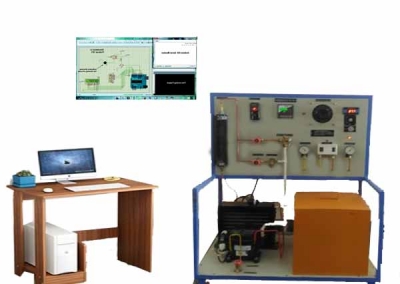- Workshop Tools and Workshop Machines India: buy@naugra.com

Vapour Compression Refrigeration Trainer .
The experimental unit represents a typical refrigeration circuit consisting of a hermetic piston compressor, condenser, expansion valve and evaporator. The evaporator and condenser are transparent to provide good monitoring of the phase transition process during evaporation and condensation. The operation of the float valve as expansion valve is also easy to observe. Before the entry into the evaporator the aggregate state of the refrigerant can be monitored at a sight glass. A water circuit cools the condenser or supplies the cooling load for the evaporator. Cold and hot water and refrigerant flows are adjustable. The low-pressure level of the refrigerant SES36 used permits the use of an evaporator and condenser out of glass. The refrigerant is CFC-free and environmentally friendly.
Vapour compression refrigeration system a refrigerant flows through the refrigeration circuit and is subject to different changes of state. Here, the physical effect is used that during the transition of the refrigerant from a liquid to a gaseous state energy is required which is removed from the environment.
FEATURES
For better process monitoring the evaporator and condenser are of transparent design
Design and operation of a compression refrigeration system
Represent and understand the refrigeration cycle in the log p-h diagram
Energy balances
- calculation of the coefficient of performance
SPECIFICATION
Hermetic piston compressor

Capacity: 18,3cm3

Evaporator capacity: approx. 2800mL
Condenser capacity: approx. 2800mL
Measuring ranges

Temperature: 8x -20…200°C

Pressure: 2x -1…1,5bar

Flow rate (water): 2x 0…48L/h

Flow rate (refrigerant): 1x 0…700L/h
Power: 0…1200W
Required for operation
230V, 50Hz, 1 phase
230V, 60Hz, 1 phase
